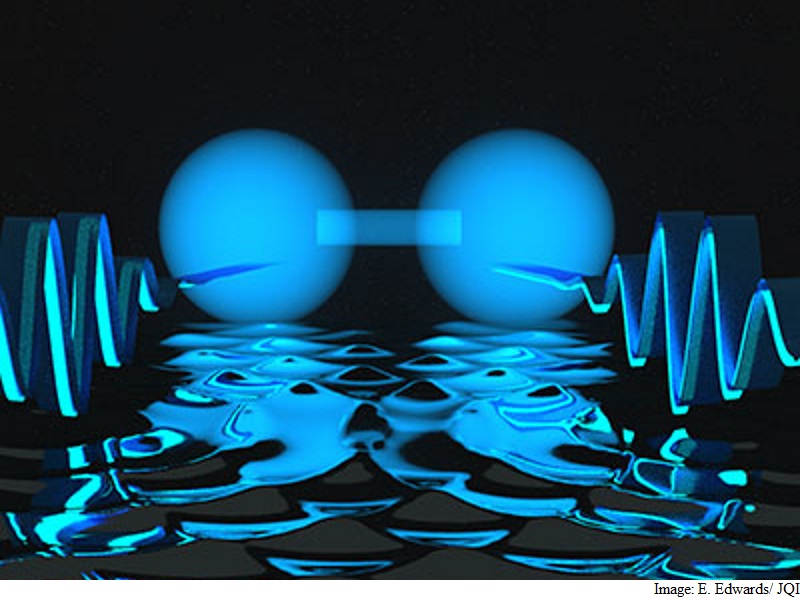- Home
- Science
- Science News
- 'Molecules' Made of Light Possible: Researchers
'Molecules' Made of Light Possible: Researchers

Now, theoretical physicists from the US National Institute of Standards and Technology (NIST) and University of Maryland have shown that by tweaking a few parameters of the binding process, photons could travel side by side, a specific distance from each other.
A photon is an elementary particle, the quantum of light and all other forms of electromagnetic radiation.
The findings hint that weightless particles of light can be joined into a sort of "molecule" with its own peculiar force.
"It is not a molecule per se but you can imagine it as having a similar kind of structure," says NIST's Alexey Gorshkov.
"We're learning how to build complex states of light that, in turn, can be built into more complex objects. This is the first time anyone has shown how to bind two photons a finite distance apart," he explained.
Lots of modern technologies are based on light, from communication
technology to high-definition imaging
"Many of them would be greatly improved if we could engineer interactions between photons," Gorshkov added.
For example, engineers need a way to precisely calibrate light sensors, and Gorshkov says the findings could make it far easier to create a "standard candle" that shines a precise number of photons at a detector.
Perhaps more significant to industry, binding and entangling photons could allow computers to use photons as information processors, a job that electronic switches in your computer do today.
Not only would this provide a new basis for creating computer technology, but it also could result in substantial energy savings.
If both the transport and the processing of the data could be done with photons directly, it could reduce energy losses.
According to Gorshkov, it will be important to test the new theory in practice for these and other potential benefits.
"It's a cool new way to study photons. They're massless and fly at the speed of light. Slowing them down and binding them may show us other things we didn't know about them before," the authors noted in a paper forthcoming in Physical Review Letters.
Catch the latest from the Consumer Electronics Show on Gadgets 360, at our CES 2026 hub.
Related Stories
- Samsung Galaxy Unpacked 2025
- ChatGPT
- Redmi Note 14 Pro+
- iPhone 16
- Apple Vision Pro
- Oneplus 12
- OnePlus Nord CE 3 Lite 5G
- iPhone 13
- Xiaomi 14 Pro
- Oppo Find N3
- Tecno Spark Go (2023)
- Realme V30
- Best Phones Under 25000
- Samsung Galaxy S24 Series
- Cryptocurrency
- iQoo 12
- Samsung Galaxy S24 Ultra
- Giottus
- Samsung Galaxy Z Flip 5
- Apple 'Scary Fast'
- Housefull 5
- GoPro Hero 12 Black Review
- Invincible Season 2
- JioGlass
- HD Ready TV
- Laptop Under 50000
- Smartwatch Under 10000
- Latest Mobile Phones
- Compare Phones
- Vivo Y500i
- OnePlus Turbo 6V
- OnePlus Turbo 6
- Itel Zeno 20 Max
- OPPO Reno 15 Pro Mini 5G
- Poco M8 Pro 5G
- Motorola Signature
- Vivo Y50e 5G
- Lenovo Yoga Slim 7x (2025)
- Lenovo Yoga Slim 7a
- Realme Pad 3
- OPPO Pad Air 5
- Xiaomi Watch 5
- Huawei Watch 10th Anniversary Edition
- Acerpure Nitro Z Series 100-inch QLED TV
- Samsung 43 Inch LED Ultra HD (4K) Smart TV (UA43UE81AFULXL)
- Asus ROG Ally
- Nintendo Switch Lite
- Haier 1.6 Ton 5 Star Inverter Split AC (HSU19G-MZAID5BN-INV)
- Haier 1.6 Ton 5 Star Inverter Split AC (HSU19G-MZAIM5BN-INV)

















